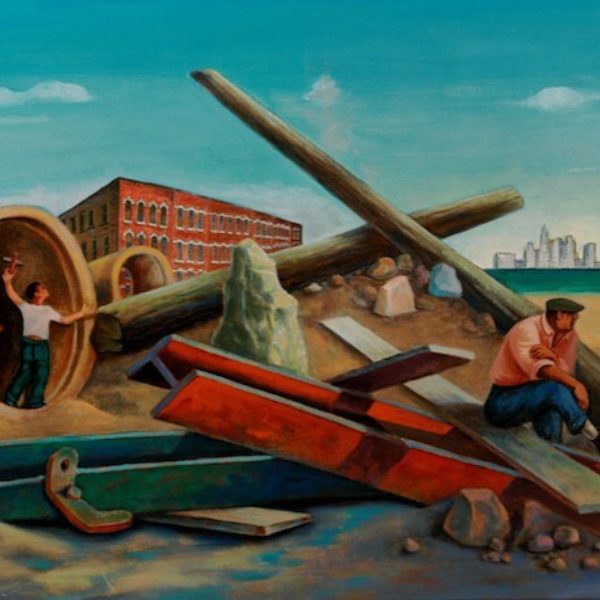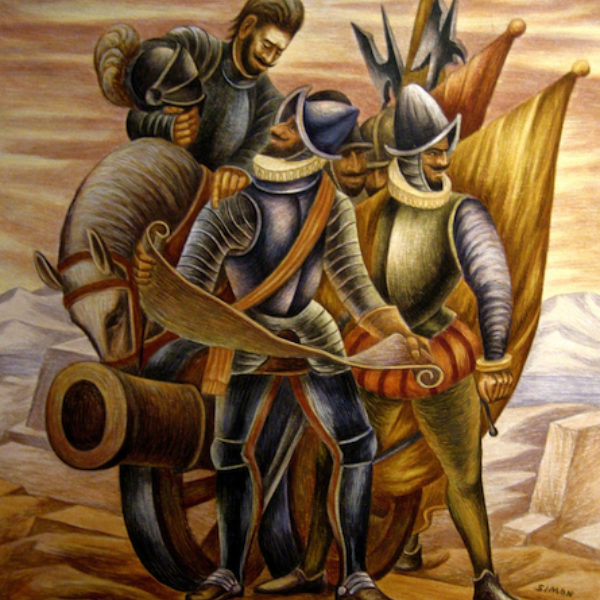
Henry Simon
b. 1901, Plock, Poland - d. 1995, Chicago, IL
With a career that spanned more than five decades, Henry Simon was one of the most prolific and versatile artists in twentieth-century Chicago, whose paintings, prints, murals, and photography engaged with some of the most significant social, cultural, and political developments of his lifetime. Born in 1901 in Poland to working-class parents, Henry and his family fled to the United States the following year to escape the threat of military conscription and pogroms. The Simons settled on the northwest side of Chicago in a neighborhood populated primarily by Polish Jews.
Henry dropped out of high school at the age of fifteen to apprentice in a sign shop, where he met an artist who encouraged him to study art and introduced him to the collection of the Art Institute of Chicago. Around this time, he joined a lettering class, taking a slot vacated by his older brother, Max, who had enlisted in the Navy in World War I. Simon sought more formal academic training in evening classes at the Chicago Academy of Fine Arts and, beginning in 1920, at the School of the Art Institute of Chicago (SAIC). There, he studied life drawing with Charles Schroeder and J. Allen St. John, and illustration and advertising design with Carl Hoeckner and Park Phipps. Although he never pursued a degree, Simon continued to take part-time classes in drawing and illustration at SAIC until 1935. While pursuing studies in art, Simon supported his family by working as a sign painter and apprenticed as a poster and stage set designer with the movie theater chain Balaban & Katz, under the direction of artist A. Raymond Katz.
Simon became increasingly politicized in the mid-1930s, through both his art and his involvement in leftist organizations, such as the John Reed Club. Together with his wife, Eve, the couple attended Club events where they interacted with other leftist sympathizers including artists Todros Geller, Morris Topchevsksy, and Alex Topp. The Club encouraged members to promote socialist ideals in their work, and to circulate their images broadly. Embracing this democratic trend, Simon expressed his concern for the nation’s economic and social ills through his lithographs as well as his political cartoons for the left-wing Midwest Daily Record.
During the Depression, Simon worked in the easel and mural divisions of the Illinois Art Project (IAP). In a short biographical sketch, he characterized his tenure at the IAP from 1936–42 as his “most prolific period.” City View from Gary, an oil painting from this time, visualizes the plight of most Americans during the Depression in an accessible, realist style. Simon anchored his composition with a graveyard of architectural elements on an expanse of beach in Gary, Indiana. Resting amid rocks, rubble, and massive storm drainpipes, the discarded piers, planks, and beams signify failed endeavors and economic decline. In the middle ground, gaping rows of windows of a massive Romanesque revival edifice—a style considered obsolete in the 1930s—evoke the vacancies left behind by factory shutdowns and human flight. The building’s radical foreshortening, underscored by the thrusting diagonal of the pier below, points insistently toward Chicago’s futuristic skyscrapers. Beacons of progress, modernity, and corporate success, they are elusive apparitions to the downcast man seated on the beach.
During his tenure at the IAP, Simon increasingly turned his attention to mural painting and shifted away from his leftist subjects to scenes more suited to public art. Simon’s technique and approach to mural design were greatly influenced by Chicago artists Mitchell Siporin, Edgar Britton, and Edward Millman, all of whom had traveled to Mexico in the late 1920s and early 1930s, where they learned about the work of Mexican muralists. Simon’s commissions for Cook County Hospital (1939) and McKendree College of Lebanon, Illinois (1940–41), led to mural projects for post offices in Osborn, Ohio (1941) and DeQueen, Arkansas (1943).
Conquistadores Discover California (1941) is a colored pencil sketch from a mural cycle that Simon and Chicago artist Arthur Lidov submitted to the 1941 competition for the Rincon Annex Post Office in San Francisco. Comprised of twenty-seven panel studies, the sequence recounts a continuous pictorial history of California from sixteenth-century Spanish explorations to the Gold Rush and the American Civil War. In this scene, a group of conquistadors begins its territorial conquest in a rocky, desolate landscape. Their heavily fortified bodies, together with the cannon, the cavalry officer, and the ominous bladed halberds in the background, all signify the military might of the Spanish empire. Although the entry did not win the competition, an honorable mentioned earned Simon recognition and future commissions.
After a hiatus from art making in the early 1950s, Simon re-emerged a few years later as a photographer. His documentary-style photographs of Chicago streets and people from the 1960s were shown in a solo exhibition at the Art Institute in 1973. In recent decades, exhibitions of Simon’s work at the College of Lake County Community Gallery of Art and at the Mary and Leigh Block Gallery at Northwestern University have advanced a more complete understanding of his lengthy career and diverse contributions to American art.
Patricia Smith Scanlan
References
Artner, Alan G. “Sentimental Journey: The Long Career of Chicago Artist Henry Simon.” Chicago Tribune. October 17, 1997.
Falk, Peter Hastings, ed. The Annual Exhibition Record of the Art Institute of Chicago, 1888–1950. Madison, CT: Soundview Press, 1990.
Glowacki, Peggy. “Bringing Art to Life: The Practice of Art at Hull-House.” In Pots of Promise: Mexicans and Pottery at Hull-House, 1920–40, edited by Cheryl R. Ganz and Margaret Strobel, 5-29. Urbana: University of Illinois Press with the Jane Addams Hull-House Museum, Chicago, 2004.
Gray, Mary Lackritz. A Guide to Chicago’s Murals. Chicago: University of Chicago Press, 2001.
Heise, Kenan. “Henry Simon, Letter Designer and WPA Painter.” Chicago Tribune. July 8, 1995.
“Henry Simon.” Vertical file, Chicago Artists’ Archives, Harold Washington Library Center, Chicago.
Jones, Steven. Henry Simon: W.P.A. Artist. Grayslake, IL: Community Gallery of Art, College of Lake County, 1987.
———. New Deal Art: Paintings and Prints 1933–1943. Grayslake, IL: Community Gallery of Art, College of Lake County, 1988.
Seaton, Liz. Henry Simon, 1901–1995. Chicago: Mary and Leigh Block Gallery, Northwestern University, 1997.
WPA Art: Prints and Mural Studies. Grayslake, IL: Community Gallery of Art, College of Lake County, 2001.
Artist Image: Untitled [Self Portrait], 1960s / Henry Simon. Gelatin silver print. 15 x 13.9 cm. Art Institute Chicago.

